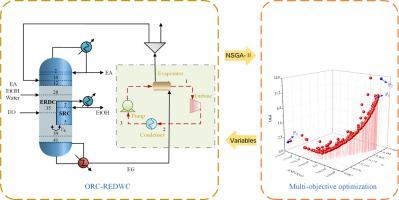Separation and Purification Technology ( IF 8.1 ) Pub Date : 2022-01-17 , DOI: 10.1016/j.seppur.2022.120512 Jiyan Liu 1 , Jianlin Yan 1 , Wenshuo Liu 1 , Jie Kong 1 , Yang Wu 1 , Xinnong Li 1 , Lanyi Sun 1

|
It is challenging and inevitable for the separation of ternary azeotropic mixture with multiple azeotropes in wastewater. Previous research proposed a hybrid double column reactive-extractive distillation (DCRED) process to separate ternary azeotropes in wastewater, which inspires the investigation into the reactive-extractive dividing wall column (REDWC) in this study. However, the design and waste heat recovery of REDWC have not been fully studied. To this end, two hybrid distillation processes, the REDWC process and the REDWC with feed preheating (REDWC-FP) process, are developed to separate ethyl acetate/ethanol/water ternary azeotropic mixture. The design parameters of the two hybrid distillation processes are optimized based upon the maximum total annual cost (TAC), CO2 emissions and minimum process route index (PRI) through the multi-objective genetic algorithm (MOGA) considering safety. In view of massive waste heat in the REDWC process, several new configurations combining the REDWC and Organic Rankine cycles (ORCs) are further proposed. The optimal ORC system is determined via MOGA with the annual net profit, ORC thermodynamic efficiency and PRI as objective functions. Compared with the existing DCRED process, the TAC and CO2 emissions of the REDWC process are reduced by 8.15% and 4.49%, respectively. The TACs of the ORC1-REDWC process with working fluid cyclohexane and the ORC2-REDWC process with working fluid benzene are reduced by 27.50% and 26.32%, respectively.
中文翻译:

考虑安全性的有机朗肯循环反应萃取间壁塔设计与多目标优化
废水中与多种共沸物的三元共沸混合物的分离具有挑战性和必然性。先前的研究提出了一种混合双塔反应萃取蒸馏 (DCRED) 工艺来分离废水中的三元共沸物,这激发了本研究对反应萃取分隔壁塔 (REDWC) 的研究。然而,REDWC的设计和余热回收尚未得到充分研究。为此,开发了两种混合蒸馏工艺,即REDWC工艺和带有进料预热的REDWC(REDWC-FP)工艺,以分离乙酸乙酯/乙醇/水三元共沸混合物。两种混合蒸馏工艺的设计参数基于最大年总成本(TAC)CO 2进行优化通过考虑安全性的多目标遗传算法(MOGA)的排放和最小工艺路线指数(PRI)。鉴于 REDWC 过程中的大量余热,进一步提出了几种结合 REDWC 和有机朗肯循环 (ORC) 的新配置。以年净利润、ORC热力学效率和PRI为目标函数,通过MOGA确定最优ORC系统。与现有DCRED工艺相比,REDWC工艺的TAC和CO 2排放量分别降低了8.15%和4.49%。ORC1-REDWC工艺采用工作液环己烷和ORC2-REDWC工艺采用工作液苯的TACs分别降低了27.50%和26.32%。











































 京公网安备 11010802027423号
京公网安备 11010802027423号